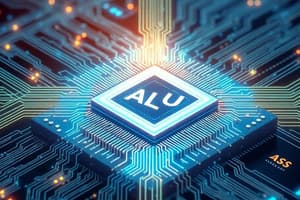Podcast
Questions and Answers
What is the primary responsibility of a system administrator?
What is the primary responsibility of a system administrator?
To install, configure, maintain, and upgrade computer systems.
How does the architecture of a computer differ from its organization?
How does the architecture of a computer differ from its organization?
Architecture refers to the visible attributes like instruction sets, while organization deals with the implementation of these features.
Provide an example of an input device and explain its role in the IPO model.
Provide an example of an input device and explain its role in the IPO model.
A keyboard, which allows users to input data into the computer system.
What is the significance of back-compatibility in Intel's x86 architecture?
What is the significance of back-compatibility in Intel's x86 architecture?
Describe a characteristic of memory technology in computer organization.
Describe a characteristic of memory technology in computer organization.
What role does a web designer play regarding system administration?
What role does a web designer play regarding system administration?
Explain how organization affects the execution of arithmetic operations in a CPU.
Explain how organization affects the execution of arithmetic operations in a CPU.
What is the input function of a magnetic tape in a computer system?
What is the input function of a magnetic tape in a computer system?
What is the primary function of the Central Processing Unit (CPU) in a computer system?
What is the primary function of the Central Processing Unit (CPU) in a computer system?
Name at least three essential components of computer hardware.
Name at least three essential components of computer hardware.
What are two common methods of data storage in computers?
What are two common methods of data storage in computers?
Describe the role of input and output operations in a computer system.
Describe the role of input and output operations in a computer system.
What distinguishes volatile memory from non-volatile memory?
What distinguishes volatile memory from non-volatile memory?
How does Moore's Law relate to memory and computing power in modern computers?
How does Moore's Law relate to memory and computing power in modern computers?
What is the primary function of the Arithmetic Logic Unit (ALU) in a CPU?
What is the primary function of the Arithmetic Logic Unit (ALU) in a CPU?
How does the Control Unit (CU) contribute to computer operations?
How does the Control Unit (CU) contribute to computer operations?
What is the relationship between bits and bytes in computer memory?
What is the relationship between bits and bytes in computer memory?
Why is RAM referred to as primary storage in a computer system?
Why is RAM referred to as primary storage in a computer system?
What determines the largest program that can be executed in a computer?
What determines the largest program that can be executed in a computer?
How is memory capacity typically measured in computers?
How is memory capacity typically measured in computers?
What role does the CPU play in controlling peripheral devices?
What role does the CPU play in controlling peripheral devices?
How does the size of memory influence the cost of a computer?
How does the size of memory influence the cost of a computer?
Flashcards are hidden until you start studying
Study Notes
CPU Functions and Components
- The Arithmetic Logic Unit (ALU) executes operations like multiplication, division, and comparison of numbers.
- The ALU operates much faster than other computer components, enabling efficient control of external devices such as video terminals and magnetic disks.
- The Control Unit (CU) directs the processing of instructions and manages the movement of data within the CPU, sending control signals to other units.
Memory Overview
- Memory, also referred to as primary storage or RAM (Random Access Memory), consists of bits that represent values of 0 or 1, with 8 bits constituting one byte.
- Holds instructions and data via the stored program concept, utilizing semiconductor storage cells to store bits of information.
- Measured in Bytes, Kilobytes (1KB = 1024 Bytes), Megabytes (1MB = 1024 KB), Gigabytes (1GB = 1024 MB), and Terabytes (1TB = 1024 GB).
- Affects the largest executable program size, execution speed, and overall computer cost.
System Administrator Responsibilities
- Installs, configures, maintains, and upgrades computer systems to maximize availability and optimize performance.
- Ensures the security of systems.
Web Designer Role
- Enhances customer accessibility to web services while managing web server administration.
- Selects suitable data formats and designs efficient web pages.
Architecture vs. Organisation
- Computer architecture pertains to attributes visible to programmers, such as instruction sets and addressing techniques.
- Organisation involves implementation aspects, including control signals and memory technology.
- The ability to perform complex operations, like division or multiplication, in a single instruction indicates better architecture.
Intel and IBM Architectures
- Intel X86-based computers share a basic architecture, ensuring compatibility with older models (e.g., Intel486 with Intel386).
- IBM System/370 family also maintains architectural compatibility across its models.
Input-Process-Output Model (IPO)
- Input devices include keyboards, mice, scanners, magnetic tapes, and CD-ROMs.
- The model illustrates how input is processed to produce output.
Historical Development of Computers
- 1937: Mark I, the first electronic computer built using relays.
- 1939: ABC, the first fully electronic digital computer utilizing vacuum tubes.
- 1943-46: ENIAC, the first general-purpose digital computer.
- 1945: Proposal of the Von Neumann architecture, which remains a standard.
- 1947: Invention of the transistor, revolutionizing computer hardware.
- 1951: UNIVAC, the first commercially available computer.
Advances in Computer Technology
- Significant improvements in size, cost, and memory capacity over time.
- Networking has become essential in modern systems, driving mobile device markets.
- Processor capacity is now a key classification instead of memory capacity.
- Computing power has seen exponential growth, in line with Moore’s Law.
Summary of Key Concepts
- Differentiation between architecture and organization in computer design.
- Recognition of basic computer tasks and data processing methods.
- Understanding the components of a computer system.
- Application of the Input-Process-Output model and its component integration: hardware, software, communication, and data.
Studying That Suits You
Use AI to generate personalized quizzes and flashcards to suit your learning preferences.




